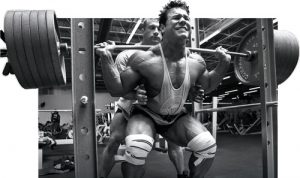The question of squat depth is one asked a lot by beginners and debated now and again by advanced lifters. Watch your local gym’s squat rack for a while, and you’ll see some lifters squat no deeper than a lady’s curtsy while others squat deep enough to pick up a quarter with their behind. Who’s got it right, or does it depend?
The reality is the ideal squat depth can depend on your goals and limitations, but for most of us one squat depth is best. The vast majority of healthy lifters should be squatting down until the top of the thigh near the hip drops just below the top of the knee (i.e. parallel). The picture at the top of this post illustrates. At that depth, the quads, glutes, and smaller muscles surrounding the hip have been fully engaged. Done with proper form and flexibility, squatting to that depth will maximize your lower body development and minimize your chance of injury.
What about squatting high?

There are some practical reasons for stopping at a depth above parallel. One reason is to keep the stress of the exercise on your quads, which is why a lot of bodybuilders squat high. The problem with that approach is that squats are not an isolation exercise. When you squat high to isolate the quads, you’re missing out on the main point of the exercise which is to work the quadriceps, glutes, hamstrings, and core in unison. There are better exercises out there for isolating the quads such as leg extensions and hack squats, so if isolation is your objective you’d be better off doing those instead.
Another reason some people squat high is to overload their body with heavier weights. The main problem there is the additional stress on your joints. Reversing directions while above parallel puts a lot of stress on the patella tendon, and the heavier weights used put unnecessary stress on the spine. More risk + less development = bad idea.
What about squatting low?

Some people will tell you that the lower you squat the better, but rock bottom butt-to-ankles squats are really only necessary if you’re training to be an Olympic style weightlifter. Most people do not have the flexibility to squat that deep without rounding the lower back and losing tightness in the midsection (aka “buttwink”) which make the movement dangerous for the lower back. Rock bottom squats also encourage bouncing out of the bottom position which is hard on the knees. Squatting to that extreme depth doesn’t develop more strength or muscle than going to just below parallel, so there’s no reason to subject your body to the additional stress.
Real Life Examples


Luckily we have some great real life examples to help put the squat depth controversy to rest: Olympic lifters, who squat to rock bottom, and powerlifters, who squat to parallel. There are plenty of lifters in each group with great leg and glute development and a high level of squatting strength. However, having been involved in both sports for many years, I can tell you that powerlifters are generally stronger squatters and have more lower body development than Olympic lifters. Furthermore, the strongest American Olympic lifters in history, Shane Hamman and Mark Henry, both developed their leg strength as powerlifters using parallel squats, so it would be hard to argue that rock bottom squats are superior.
A Word of Caution
It’s important to keep your back flat/neutral when you squat to avoid getting hurt. If you have tight hamstrings or poor squatting form, you might not be able to reach parallel depth without your lower back rounding. In that case, you should squat only as deep as you can while keeping a flat back, and work on your form and flexibility until you can get down lower. There are also some knee injuries that prevent one from safely bending the knee more than 90 degrees while under load. If you have those or other medical issues, check with a doctor who deals with athletes to determine the appropriate squat depth for you.



2 Comments
Some people will be unable to maintain a neutral spine any lower than parallel the point where your hips are roughly level with your knees. Physiologically, not everyone can hit rock bottom without relaxing their lower back arch, while others lack sufficient strength or flexibility at the hip, knee and ankle to perform the deep squat safely.
Well said Brielle! I do not recommend squatting any deeper than the point at which proper form can be maintained.